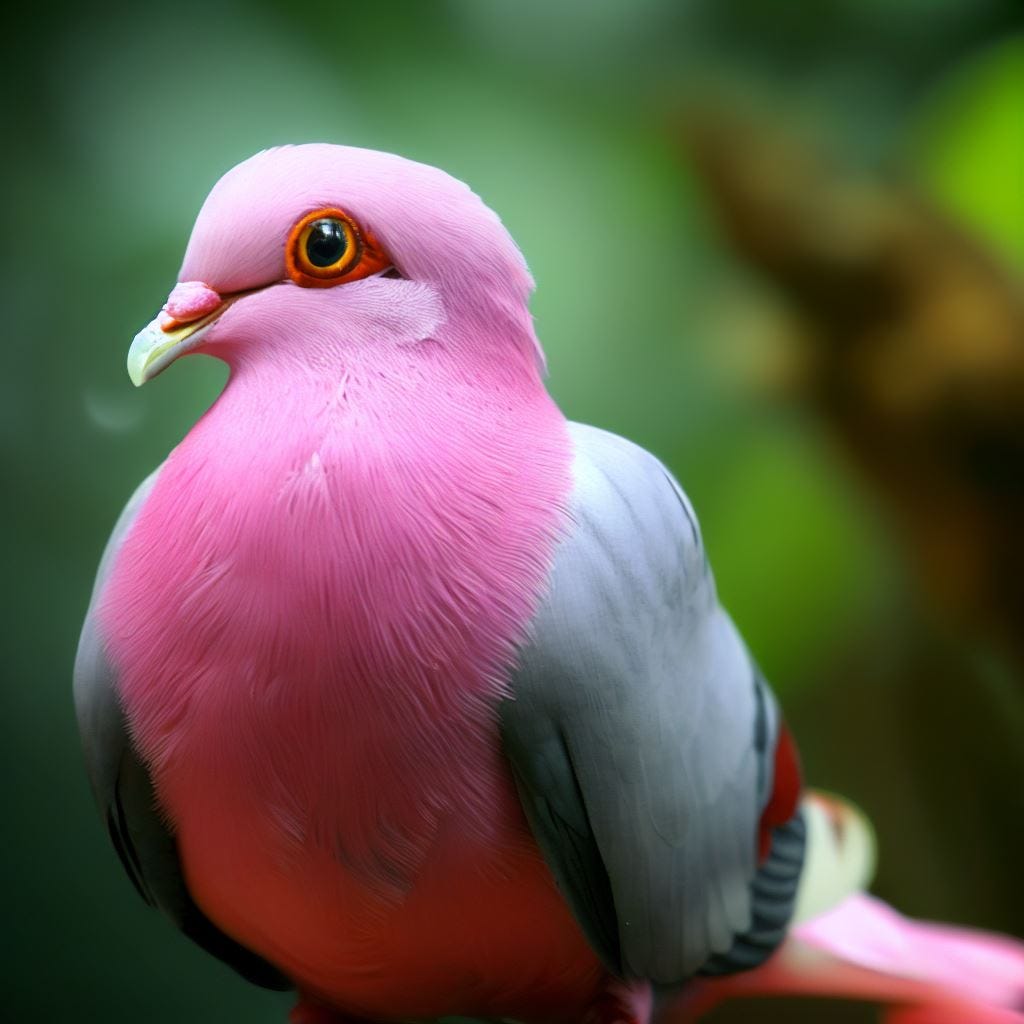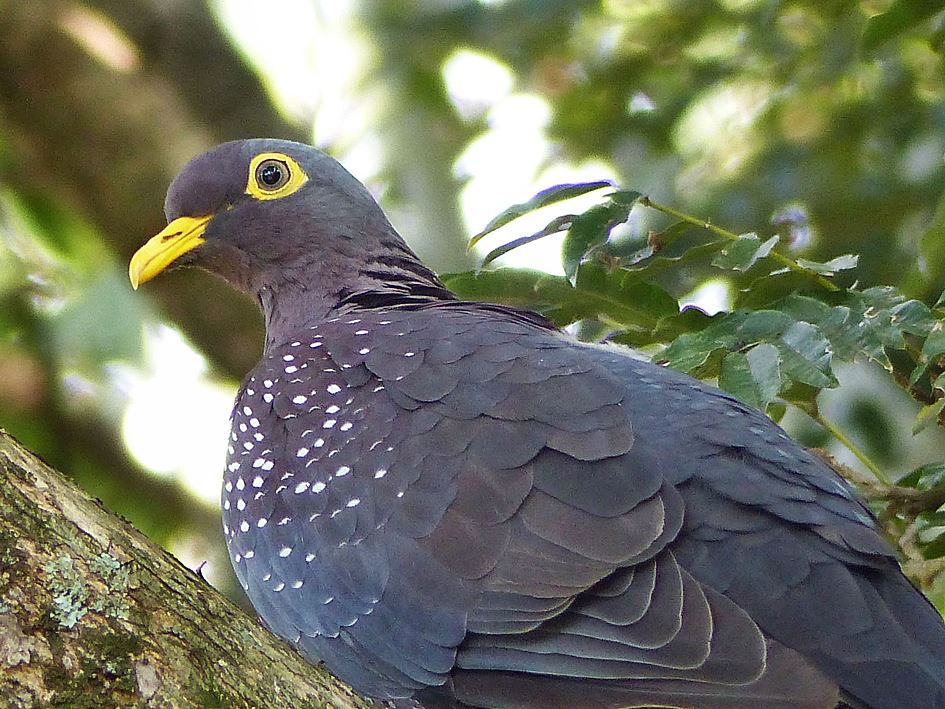The Speckled Pigeon is a bird species known for its distinctive speckled plumage. It is commonly found in Africa.
The Speckled Pigeon (Columba guinea) is a bird species native to Africa. Known for its distinctive speckled plumage, this pigeon is widely found across the continent. Its overall appearance is characterized by a chestnut-colored back, wings, and tail, speckled with white spots, and a slate-gray head and breast.
Considered a medium-sized pigeon, it typically measures around 34–37 cm (13–14. 5 in) in length. Speckled Pigeons are adaptable birds that inhabit a variety of habitats, including mountains, savannahs, forests, and urban areas. They mainly feed on seeds but also consume fruits, crops, and insects. Due to their widespread distribution and population numbers, the Speckled Pigeon is not currently classified as a threatened species.
The Fascinating World Of Speckled Pigeons
The fascinating world of speckled pigeons is filled with wonder and intrigue. These captivating birds are known for their beautiful appearance, unique physical characteristics, and choice of natural habitats. This blog post will provide an in-depth exploration of the various aspects of speckled pigeons, from an overview of their species to their natural habitats and distribution. Get ready to dive into the mesmerizing world of speckled pigeons!
Overview Of Speckled Pigeons
Speckled pigeons, scientifically known as Columba guinea, are a species of birds that belong to the Columbidae family. These pigeons are widely spread across parts of Africa and are particularly common in sub-Saharan regions. What makes speckled pigeons stand out is their unique plumage that is characterized by a symphony of speckles covering their body.
These birds generally have a plump body, short neck, and a small head. While their size may vary slightly, with an average length of 28 to 32 centimeters, their unmistakable appearance makes them easy to identify. The fascinating combination of various shades of gray and brown creates a mesmerizing pattern on their feathers, making them one of the most visually appealing pigeon species.
Physical Characteristics And Unique Features
The physical characteristics of speckled pigeons are what truly set them apart. With a rounded body, short legs, and a relatively small head, they have adapted well to their natural habitats. Their wings are broad and provide excellent maneuverability during flight, allowing them to navigate through various terrains with ease.
One of the most distinctive features of speckled pigeons is their plumage. The feathers are predominantly speckled with shades of gray and brown, creating a beautiful pattern that helps them blend into their surroundings. This camouflage is a crucial defense mechanism, protecting them from potential predators.
Another unique feature of speckled pigeons is their ability to produce resonating vocal sounds. They are known for their melodious cooing, which is often heard during mating rituals or as a form of communication between individuals. This acoustic ability plays a significant role in their social interactions and courtship behavior.
Natural Habitats And Distribution
Speckled pigeons have a diverse range of natural habitats across Africa. They are commonly found in open grasslands, savannas, scrublands, and even urban areas. These adaptable birds have successfully adapted to different environments and can be observed in both rural and urban settings.
Their distribution spans across sub-Saharan regions, including countries such as South Africa, Zimbabwe, and Ethiopia. They have also been observed in parts of North Africa, particularly in Morocco and Algeria. The ability of speckled pigeons to thrive in various habitats contributes to their widespread distribution.
Evolution And Adaptations Of Speckled Pigeons
Speckled pigeons, scientifically known as Columba guinea, are a fascinating species that have evolved and adapted over time to survive in diverse environments. The evolutionary history of speckled pigeons, their adaptations for survival, and their ecological importance make them a truly remarkable bird. Let’s explore each of these aspects in detail.
Evolutionary History Of Speckled Pigeons
The evolutionary history of speckled pigeons traces back to their common ancestor, the rock pigeon. Over the course of millennia, speckled pigeons have undergone genetic variations and adaptations that have allowed them to thrive in various habitats. These adaptations have played a crucial role in their survival and propagation.
Adaptations For Survival In Diverse Environments
Speckled pigeons have developed a range of adaptations that enable them to survive and thrive in diverse environments. These adaptations include:
- Camouflaged plumage: The speckled pattern on their feathers helps them blend seamlessly into their surroundings, providing effective camouflage against potential predators.
- Powerful flight: Speckled pigeons have strong wing muscles and streamlined bodies, allowing them to navigate long distances swiftly. This adaptation aids them in finding food sources and escaping from predators.
- Flexible diet: These birds have adapted to be omnivorous, feeding on both plant matter and small insects. This adaptability enables them to survive in a wide range of habitats and find food even in challenging conditions.
- Nesting behavior: Speckled pigeons build nests in areas that provide safety and protection, such as cliffs and crevices. Their ability to adapt their nesting habits allows them to optimize their chances of survival and successful reproduction.
Importance Of Speckled Pigeons In Their Ecosystems
Speckled pigeons play a vital role in their ecosystems. Their presence helps in pollination and seed dispersion, contributing to the growth and reproduction of various plant species. Additionally, they act as a food source for many predators, facilitating the transfer of energy within the food chain.
In conclusion, the evolution and adaptations of speckled pigeons have equipped them with the necessary tools for survival in diverse environments. Their camouflaged plumage, powerful flight, flexible diet, and nesting behavior are all essential traits that have contributed to their success as a species. Furthermore, their ecological importance ensures a balance within their ecosystems, making them a species worth appreciating and studying.
The Colorful Plumage Of Speckled Pigeons
Speckled pigeons are known for their vibrant and eye-catching plumage. Their colorful feathers add a touch of beauty to the natural world, making them an intriguing species to study. In this article, we will explore the various types of speckled patterns and color variations seen in these pigeons, discuss the factors that influence their coloration, and shed light on the significance of their plumage in mate attraction and species recognition.
Types Of Speckled Patterns And Color Variations
Speckled pigeons exhibit a wide range of patterns and color variations in their plumage. Here are some notable ones:
| Pattern | Description |
|---|---|
| Solid speckles | Pigeons with this pattern have densely packed speckles all over their feathers, creating a solid effect. |
| Scattered speckles | Pigeons with this pattern have speckles scattered unevenly across their feathers, giving them a unique and random appearance. |
| Linear speckles | Pigeons with this pattern have speckles arranged in linear or parallel lines, creating a visually appealing striped effect. |
Color variations can include a wide spectrum, ranging from earthy tones like brown and gray to more vibrant hues like red, green, and blue. Some pigeons may even have iridescent feathers that shimmer and change color when viewed from different angles.
Factors Influencing Coloration In Speckled Pigeons
The striking coloration of speckled pigeons is influenced by several factors:
- Genetics: Genetic variations play a significant role in determining the color and speckled patterns in these pigeons. Different combinations of genes can result in unique colorations.
- Environment: The environment in which speckled pigeons live can affect the intensity of their colors. Factors such as sunlight exposure, diet, and habitat conditions can influence the pigmentation of their plumage.
- Social status: Research suggests that dominant pigeons may have more vibrant and attractive plumage compared to subordinate individuals. This could be due to hormonal differences or the effects of social interactions.
Significance Of Plumage In Mate Attraction And Species Recognition
The colorful plumage of speckled pigeons serves important functions in mate attraction and species recognition:
- Mate attraction: Bright and visually appealing plumage often acts as a signal to potential mates, indicating good health and genetic fitness. Pigeons with more striking colors may have an advantage in attracting a mate and securing successful reproduction.
- Species recognition: The unique coloration of speckled pigeons helps individuals recognize members of their own species. This is crucial for proper mate selection and avoiding hybridization with other pigeon species.
In conclusion, the colorful plumage of speckled pigeons is a captivating sight. The various patterns and color variations, influenced by genetics, environment, and social factors, contribute to the attractiveness and species recognition among these birds. Understanding the significance of their plumage allows us to appreciate the beauty and complexity of the natural world.

Credit: medium.com
Behaviors And Social Structure Of Speckled Pigeons
Breeding Rituals And Courtship Displays
The breeding rituals and courtship displays of Speckled Pigeons are fascinating to behold. During the breeding season, male pigeons perform elaborate displays to attract a mate. These displays often include puffing up their chests, cooing loudly with their wings raised in a majestic manner, and strutting around the female pigeons with an air of confidence. The purpose of these displays is to impress the females and establish their dominance in the pecking order.
Nesting Habits And Parental Care
When it comes to nesting habits, Speckled Pigeons are quite selective. They prefer to build their nests in sheltered locations, such as ledges on cliffs or rooftops, where they can be protected from predators. The female pigeon takes the lead in constructing the nest, using materials like twigs, leaves, and feathers to create a sturdy structure. Once the nest is ready, the female lays one or two eggs, which both parents take turns incubating.
Speckled Pigeons exhibit remarkable parental care. After the eggs hatch, both the male and female pigeons take on the responsibility of providing food and warmth to their chicks. They regurgitate a special “pigeon milk” from their crops, which contains all the necessary nutrients for the fast growth and development of the young ones. This parental care ensures the survival and well-being of the offspring.
Communication Methods And Social Interactions
Communication plays a vital role in the social interactions of Speckled Pigeons. These pigeons use various methods to communicate with each other, including vocalizations, body movements, and visual displays. For instance, they communicate through coos, which can vary in tone and pitch, conveying different messages such as warning signals or mating calls.
Besides vocalizations, Speckled Pigeons also communicate through body movements. They engage in behaviors like head bobbing, wing flapping, and bowing, which can convey specific intents or emotions. These movements help establish dominance hierarchies and resolve conflicts within the flock.
Furthermore, visual displays are important for social interactions among Speckled Pigeons. They display their colorful plumage, speckled feathers, and unique patterns during courtship and territorial disputes. These visual displays serve as signals to determine hierarchy, courtship intentions, or to ward off potential rivals from their territory.
Threats And Conservation Efforts For Speckled Pigeons
Speckled pigeons, with their distinctive black and white speckled plumage, are a captivating species that face various threats to their population. However, several conservation initiatives and protective measures have been implemented to safeguard these beautiful birds and ensure their continued survival.
Human-induced Threats To Speckled Pigeon Populations
Speckled pigeons face several human-induced threats that directly impact their population size and habitat. These threats include:
- Habitat loss: The continuous expansion of urban areas and agricultural development has led to the destruction and fragmentation of natural habitats, reducing the available nesting and foraging locations for speckled pigeons.
- Poaching and hunting: In some regions, these pigeons are targeted for sport hunting or captured for their attractive plumage, leading to disturbances in their population dynamics.
- Human disturbance: Speckled pigeons are sensitive to disturbances caused by human activities such as construction, noise pollution, and human presence near their nesting sites, which can disrupt their breeding patterns and cause stress to the birds.
- Pesticide use: The use of pesticides in agricultural practices can result in the contamination of food sources for speckled pigeons, leading to poisoning and detrimental effects on their reproductive success.
Conservation Initiatives And Protective Measures
A number of conservation initiatives and protective measures have been put in place to address and mitigate the threats faced by speckled pigeons. These initiatives include:
- Protected areas and reserves: Establishing protected areas and reserves specifically for speckled pigeons provides them with a secure habitat where they can breed, forage, and live without human disturbances.
- Habitat restoration: Efforts to restore and conserve the natural habitats of speckled pigeons are crucial for ensuring the availability of suitable nesting sites and sufficient food sources.
- Regulation and legislation: Strict regulations and legislation are enacted to control hunting, poaching, and trade of speckled pigeons, aiming to minimize their exploitation and protect their populations.
- Educational programs: Awareness campaigns and educational programs are conducted to educate local communities about the importance of conserving speckled pigeons and their habitats, fostering a sense of responsibility and involvement from the community.
Role Of Awareness And Community Involvement In Conservation
Building awareness and fostering community involvement play vital roles in the successful conservation of speckled pigeons. When local communities understand the significance of protecting these birds and their habitats, they are more likely to actively participate in conservation efforts. By engaging communities in birdwatching activities, environmental workshops, and habitat restoration projects, individuals become directly involved in safeguarding the species. This not only benefits speckled pigeons but also creates a sense of stewardship and appreciation for the natural environment as a whole.
Frequently Asked Questions Of Speckled Pigeon
Can Speckled Pigeons Be Domesticated?
Yes, speckled pigeons can be domesticated as their natural behavior allows them to adapt well to human contact and captivity. Their resilience and ability to form bonds with humans make them suitable for domestication.
What Is The Behavior Of A Speckled Pigeon?
Speckled pigeons are sociable birds that can be found in Africa. They are known for their distinctive speckled plumage and strong flying capabilities. They often gather in flocks and can be seen perching on trees or rooftops.
What Is The Difference Between A Spotted Dove And A Pigeon?
A spotted dove is smaller than a pigeon and has distinctive markings on its feathers. Pigeons, on the other hand, are larger with a rounder body shape. Both birds belong to the Columbidae family but have distinct physical differences.
Where Are Rock Pigeons Found?
Rock pigeons are found in urban environments worldwide, including cities, towns, and suburbs. They are adaptable creatures that thrive in areas with ample food sources and nesting opportunities, such as buildings, parks, and bridges.
Conclusion
The speckled pigeon is a fascinating bird species found in various parts of the world. With its distinctive speckled plumage and impressive adaptability, it has captivated the interest of bird enthusiasts. Whether you enjoy observing their behaviors or simply appreciate their beauty, the speckled pigeon is a truly remarkable creature deserving of admiration.
Its ability to thrive in diverse environments highlights the resilience of nature and reminds us of the interconnectedness of all living things. So, next time you spot a speckled pigeon soaring through the sky, take a moment to appreciate the wonders of this unique avian species.

Maruf, a true pigeon aficionado, finds solace and joy in the company of these graceful birds. His unwavering devotion to pigeons is a testament to his deep appreciation for their beauty and grace. Maruf’s passion for caring for and nurturing these feathered friends is truly inspiring to fellow bird enthusiasts.
